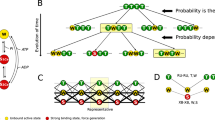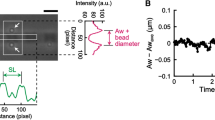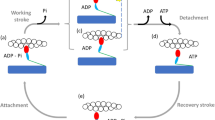Abstract
Recent studies have suggested that actomyosin threads may provide a useful model for studying the properties of contractile systems1–3. The development of highly sensitive positional feedback transducers has enabled the properties of these threads to be measured reproducibly1. Potential applications include such systems as ventricle, smooth muscle and non-muscle preparations, from which it is difficult to obtain suitable fibres for mechanical studies. In addition, studies with chemically modified myosins may provide new insights into the relationships between the biochemical and mechanical events in the cross-bridge cycle. However, there are indications that the mechanical properties of actomyosin threads differ from those of intact fibres in several important respects. For example, contraction velocity is proportional to isometric tension in threads2, but is independent of filament density in intact fibres4. We have now determined the force–velocity characteristics of actomyosin threads prepared from muscles with known differences in their physiological contraction velocities. No direct relationships could be found between the velocity characteristics of the threads and those of intact muscle. We conclude that the measured velocities of threads reflect properties of the actomyosins other than cross-bridge cycling times, thus severely limiting the usefulness of this technique for comparative purposes.
This is a preview of subscription content, access via your institution
Access options
Subscribe to this journal
Receive 51 print issues and online access
$199.00 per year
only $3.90 per issue
Buy this article
- Purchase on Springer Link
- Instant access to full article PDF
Prices may be subject to local taxes which are calculated during checkout
Similar content being viewed by others
References
Crooks, R. & Cooke, R. J. gen. Physiol. 69, 37–55 (1977).
Cooke, R. & Franks, K. E. J. molec. Biol. 120, 361–373 (1978).
Matsumura, F., Yoshimoto, Y. & Kamiya, N. Nature 285, 169–171 (1980).
Josephson, R. K. J. exp. Zool. 194, 135–154 (1975).
Lehman, W. & Szent-Györgyi, A. G. J. gen. Physiol. 66, 1–30 (1975).
Spudich, J. A. & Watt, S. J. biol. Chem. 246, 4866–4871 (1971).
Barany, M. & Close, R. I. J. Physiol., Lond. 213, 455–474 (1971).
Flitney, F. W. & Johnston, I. A. J. Physiol., Lond. 295, 49P–50P (1979).
Lännergren, J. J. Physiol., Lond. 283, 501–521 (1978).
Close, R. J. Physiol, Lond. 204, 331–346 (1969).
Barany, M. J. gen. Physiol. 50, Suppl. 197–216 (1967).
D'Haese, J. & Komnick, H. Z. Zellforsch. 134, 411–426, 427–434 (1972).
Josephs, R. & Harrington, W. F. Biochemistry 5, 3474–3487 (1966).
Kaminer, B. & Bell, A. L. J. molec. Biol. 20, 391–401 (1966).
Pinset-Härström, I. & Truffy, J. J. molec. Biol. 134, 173–188 (1979).
Pinset-Härström, I. & Whalen, R. G. J. molec. Biol. 134, 189–197 (1979).
Syrovy, I. Int. J. Biochem. 10, 383–389 (1979).
Itzhaki, R. F. & Gill, D. M. Analyt. Biochem. 9, 401–410 (1964).
Hill, A. V. Proc. R. Soc. B126, 136–195 (1938).
Author information
Authors and Affiliations
Rights and permissions
About this article
Cite this article
Altringham, J., Yancey, P. & Johnston, I. Limitations in the use of actomyosin threads as model contractile systems. Nature 287, 338–340 (1980). https://doi.org/10.1038/287338a0
Received:
Accepted:
Published:
Issue Date:
DOI: https://doi.org/10.1038/287338a0
This article is cited by
-
Motion of myosin filaments due to interaction of the two-headed myosin crossbridge with two actin filaments
Journal of Muscle Research and Cell Motility (1984)
Comments
By submitting a comment you agree to abide by our Terms and Community Guidelines. If you find something abusive or that does not comply with our terms or guidelines please flag it as inappropriate.



